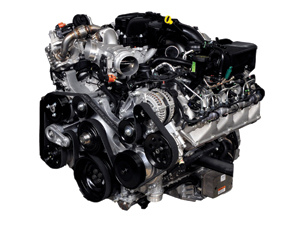It may be a cliché that middle-aged engineers, saddled with a midlife crisis and perhaps a divorce, return to their youth for inspiration. But Ford Motor Co.’s Power Stroke designers did just that. They found solace in the Scorpions, the German rock band that sang “Rock You Like a Hurricane,” while Ford battled with a longtime engine supplier. The project’s code word, Scorpion, stuck as the unofficial name of Ford’s new 6.7-liter diesel in its F-Series work trucks.
Clichés aside, the 2011 Power Stroke, slated for production soon in Chihuahua, Mexico, leaves behind the head-banging 1980s with refined combustion that delivers less noise pollution than other diesels working on the jobsite.
The 6.7 also marks the historic end of a decades-long supply deal between Ford and Navistar, which will build Fords last engine on Dec. 31. This past January, the two firms settled claims over the reliability of early emissions controls embodied in their 6.0-liter Power Stroke. A more reliable 6.4 came out four years later, in 2007. By then, Ford had started work on Scorpion. Navistar’s contract would have expired in 2012.
During a preview this summer at Ford’s design center in Dearborn, Mich., ENR heard Scorpion run in a current F-450 work truck and had a hard time believing a diesel was under the hood. Ford engineers say the extremely quiet motor also will deliver significant horsepower, torque and fuel-economy improvements, but they are not yet disclosing ratings.
Scorpion cuts nitrogen-oxide emissions (NOx) more than 83% from 2007 levels, a requirement under U.S. tailpipe regulations—the world’s toughest. And a new NOx scrubber that uses urea injection, common to most heavy-duty diesels today, helps the cause. Contractors will appreciate that the new engine can run on 20% biodiesel, or B20, and will be even happier to hear an export option that runs on dirty diesel will be available with the new Super Duty truck, Ford says.
New to this class of diesel is a compacted graphite-iron block, common to light European diesels, that replaces heavy cast iron but is twice as strong. Aluminum heads also are new. Because the Super Duty is a work truck, “a key design imperative was saving weight,” says Adam Gryglak, chief engineer.

Adam Gryglak
Chief Engineer,
His team packs economy and power into a quieter diesel.
Heads are reversed so the Honeywell turbocharger can sit in the V. This halves exhaust plumbing and allows finer temperature control, which reduces turbo lag, cuts emissions and boosts fuel economy. An exhaust-gas-recirculation valve now sits on the hot side of the EGR cooler. The previous colder valve would plug up with soot and was the 6.4’s most frequent warranty item, Gryglak notes.
Although Ford deleted a second turbo (the new one spins two compressors on one shaft), it added a water pump. It manages a charge-air cooler, again for emissions control, piped into a secondary loop kept at 122°F, compared to the engine’s 194° loop. Both flow through the main radiator in separate compartments.
The real power stroke of genius is how quiet it all sounds. A Bosch-supplied fuel pump, 30,000-psi common rail and piezo nozzles deliver up to five injections per cycle. At idle, twin pilots followed by a main injection make the rig hum without violent clattering. A nylon-composite intake resonator on top of the engine and melamine-foam dampers that clip over the side rocker covers further tune out engine noise.
The result is stunning. “Our customers gave us a lot of feedback,” explains Scott DeRaad, Ford’s noise-vibration-harshness engineer. “They would go through a drive-through window and have to shut off their truck just to order a cheeseburger.”












Post a comment to this article
Report Abusive Comment